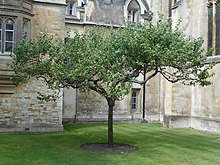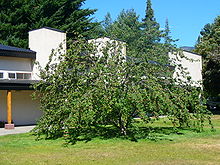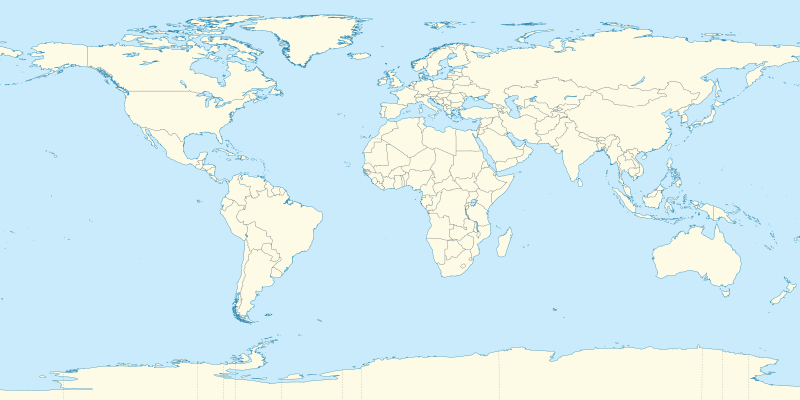Isaac Newton's apple tree
| Isaac Newton's apple tree | |
|---|---|
 The tree in Woolsthorpe Manor | |
| Species | Flower of Kent, Malus domestica |
| Coordinates | 52°48′32.7″N 00°37′51″W / 52.809083°N 0.63083°W |
| Date felled | 1816 (regrown) |
| Custodian | National Trust |
| Website | www |
Isaac Newton's apple tree at Woolsthorpe Manor[1][2] represents the inspiration behind Sir Isaac Newton's theory of gravity. While the precise details of Newton's reminiscence (reported by several witnesses to whom Newton allegedly told the story) are impossible to verify, the significance of the event lies in its explanation of Newton's scientific thinking. The apple tree in question, a member of the Flower of Kent variety, still exists today at the manor; it is a direct descendant of the tree that stood in his family's garden in 1666. It stands as a living connection to Newton's groundbreaking insights. The tree has become a cherished symbol, and its descendants and clones can be found in various locations worldwide.
The apple incident[edit]
It is known from his notebooks that Isaac Newton was grappling in the late 1660s with the idea that terrestrial gravity extends, in an inverse-square proportion, to the Moon; however, it took him two decades to develop the full-fledged theory.[3] The question was not whether gravity existed, but whether it extended so far from Earth that it could also be the force holding the Moon to its orbit. Newton showed that if the force decreased as the inverse square of the distance, one could indeed calculate the Moon's orbital period, and get good agreement. He guessed the same force was responsible for other orbital motions, and hence named it "universal gravitation".[4]
Newton himself often told the story that he was inspired to formulate his theory of gravitation by watching the fall of an apple from a tree.[5][6][7] The story is believed to have passed into popular knowledge after being related by Catherine Barton, Newton's niece, to Voltaire.[8] Voltaire then wrote in his Essay on Epic Poetry (1727), "Sir Isaac Newton walking in his gardens, had the first thought of his system of gravitation, upon seeing an apple falling from a tree."[9][10][11]
Some have argued that the apple story is a fiction and that he did not arrive at his theory of gravity at any single moment.[12] Acquaintances of Newton (such as William Stukeley) recorded Newton's version of the incident, though not the meritless version that the apple actually hit Newton's head.[13][14][15] Stukeley recorded in his Memoirs of Sir Isaac Newton's Life a conversation with Newton in Kensington on 15 April 1726 (50 years after the supposed event):[16]
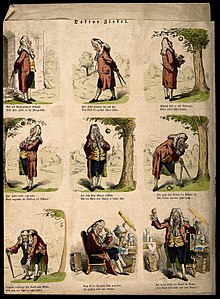
we went into the garden, & drank thea under the shade of some appletrees, only he, & myself. amidst other discourse, he told me, he was just in the same situation, as when formerly, the notion of gravitation came into his mind. "why should that apple always descend perpendicularly to the ground", thought he to him self: occasion'd by the fall of an apple, as he sat in a comtemplative mood: "why should it not go sideways, or upwards? but constantly to the earths centre? assuredly, the reason is, that the earth draws it. there must be a drawing power in matter. & the sum of the drawing power in the matter of the earth must be in the earths center, not in any side of the earth. therefore dos this apple fall perpendicularly, or toward the center. if matter thus draws matter; it must be in proportion of its quantity. therefore the apple draws the earth, as well as the earth draws the apple."
John Conduitt, Newton's assistant at the Royal Mint and husband of Newton's niece, also described the event when he wrote about Newton's life:[1]
In the year 1666 he retired again from Cambridge to his mother in Lincolnshire. Whilst he was pensively meandering in a garden it came into his thought that the power of gravity (which brought an apple from a tree to the ground) was not limited to a certain distance from earth, but that this power must extend much further than was usually thought. Why not as high as the Moon said he to himself & if so, that must influence her motion & perhaps retain her in her orbit, whereupon he fell a calculating what would be the effect of that supposition.
British science writers Mary and John Gribbin assert that Newton simply made it up,[12] because, in 1666, Newton's theory of the nature of gravity[17] would not have encompassed it. In their view, either the elderly Newton had forgotten that he had once posited it as an explanatory analogy or (more probably) because he would not admit that Robert Hooke had given him the concept of universal gravity in his [Hooke's] 1674 Gresham lecture, An Attempt to Prove the Motion of the Earth by Observations (published 1679), which explained that gravitation applied to "all celestial bodies".[18]
The tree[edit]
The actual story behind Newton's apple tree can be traced back to Newton's time at Woolsthorpe Manor, his family estate in Lincolnshire, England.[19][1][2] During his stay at the manor in 1665 or 1666, it is believed that Newton observed an apple falling from a tree and began pondering the forces that govern such motion.[20] Dendrochronology, done by the Research Laboratory for Archaeology and the History of Art at the University of Oxford, confirms one of the trees in the orchard to be over 400 years old, having regrown from roots surviving from a tree which was blown over by a storm in 1816.[21][1][22] In 1820, part of the blown tree was also cultivated by Lord Brownlow at Belton Park into a tree that came to be known as the Belton tree.[19][1][22]
Other various trees are claimed to be the apple tree which Newton describes. The King's School, Grantham claims that the tree was purchased by the school, uprooted and transported to the headmaster's garden some years later.[23] The staff of the (now) National Trust-owned Woolsthorpe Manor dispute this claim.[1]
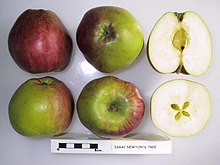
The apple tree is a culinary apple[24] of the Flower of Kent variety.[20] The Flower of Kent is known for its large and flavorful, but mealy green apples, which were used for cooking and baking.[25] The apple tree still exists today at Woolsthorpe Manor, and it is attended by gardeners, secured with a fence, and cared for by National Trust for Places of Historic Interest or Natural Beauty.[26]
Significance[edit]
While there is debate regarding the precise details of the apple tree incident, the story has become deeply ingrained in scientific history and popular culture. The apple tree symbolizes the moment of inspiration that led Newton to develop his groundbreaking ideas. It serves as a powerful metaphor for the process of scientific discovery and the ability to perceive patterns in nature.[20][27]

A statue of Isaac Newton, looking at an apple at his feet, can be seen at the Oxford University Museum of Natural History. A large bronze statue, Newton, after William Blake, by Eduardo Paolozzi, dated 1995 and inspired by Blake's etching, dominates the piazza of the British Library in London. A bronze statue of Newton was erected in 1858 in the centre of Grantham where he went to school, prominently standing in front of Grantham Guildhall.
The tree was ranked number five on the TIME TOP 10 Awesome Trees on Arbor Day in 2010,[28] and was chosen as one of the 50 Great British Trees in 2012, the year of Queen Elizabeth II's Diamond Jubilee.[29] Part of the tree was used in the state coach for Queen Elizabeth II's diamond jubilee.[30]
I'll take it up and let it float around for a bit, which will confuse Isaac
Piers Sellers on his plan for 10cm sample during the mission, Economic Times[31][32]
On 14 May 2010, British-born NASA astronaut Piers Sellers took a 10cm fragment of the Newton's apple tree into space as part of the celebrations for the 350th anniversary of the Royal Society, of which Newton was a former president. The tree sample, engraved with Newton's name, was originally taken from the Royal Society's archives and entrusted to Piers Sellers for his 12-day mission aboard the space shuttle Atlantis to the International Space Station (ISS).[33][34][35] After the mission, both the tree sample and the picture was returned to the Royal Society and became part of a historical exhibition.[36]
Seeds of the tree were sent by the European Space Agency into space to the International Space Station on the 2014-15 Principia mission with astronaut Tim Peake.[29][37] As part of the "Pips in Space" research, the seeds floated in microgravity for six months before returning to Earth in 2016 to be raised into young trees.[38] Winners of a competition to host one of the unique seedlings include the National Physical Laboratory,[39] Jodrell Bank Observatory, and the Eden Project.[38] In 2023, 10 saplings from the tree were auctioned to support the upkeep of Woolsthorpe Manor.[40]
Clones[edit]
There are several genetically identical trees, or clones, of the original apple tree that have been planted around the world. Trinity College in Cambridge, Newton's alma mater, hosts a genetically identical tree, growing outside the main gate of the college below the room Newton lived in when he studied there.[19][41][42] Woolsthorpe Manor gifted five cuttings from Newton's Apple Tree to Loughborough University, located near Newton's childhood home. These cuttings were planted at Loughborough University as part of an initiative to inspire students to think like Isaac Newton.[43] Cambridge University Botanic Garden had a clone of Newton's Apple Tree that stood at the Brookside entrance. Unfortunately, it fell during Storm Eunice.[44] Yet, the garden plans to plant a new clone elsewhere on the premises.[45] National Institute of Standards and Technology (NIST), Gaithersburg campus in the United States had a clone of Newton's Apple Tree planted.[46][22] But it fell over and died in June 2023 due to unknown reasons.[46][47]
Grace Babson, the wife of Roger Babson, was able to pursue her collection, later amounting to over 1,000 editions of Newton materials, being the largest source in the United States.[48][49] In 1995, the Babson College collection was placed on loan to MIT's Burndy Library, and in 2006, to the Huntington Library in San Marino, California, where it is available for scholarly research.[50] Between Sir Isaac Newton Library (now known as Tomasso Hall) and the Lunder Admission Center lay descendants of the original apple trees.[51] Grace also saved the parlour of Newton's last residence before its demolition and created a replica in Babson Park.[52]
From 1997 to 2007, at Inter-University Centre for Astronomy and Astrophysics three endeavors were undertaken to cultivate Newton's Apple Tree brought in by Jayant Narlikar. Some of the trees managed to thrive and produce apples. However, by 2007, the last remaining tree from those attempts had perished.[53]
Other clones can be found at Queens' College, Cambridge planted in 1948,[54] Bushy House part of the National Physical Laboratory planted in 1953,[46] the Royal Astronomical Society,[55][56] TRIUMF planted in 1968,[29] University of York gifted in 1976,[57] the Massachusetts Institute of Technology (MIT) in the United States planted in 1977,[58] Centro Atómico Bariloche planted in 1981,[29] Koishikawa Botanical Gardens in Japan planted in 1981,[59] York University, Toronto planted in 1999,[60] the University of Wisconsin-Madison's Physics Department and Botanical Garden plant on 25 May 2001,[61] University of Nebraska–Lincoln in Nebraska planted in May 2015,[62][63] Brown University in Rhode Island planted on 29 March 2018,[64] King Edward's School in Birmingham planted in 2018,[65] and Argentina's Parque de las Ciencias planted in 2022.[66]
More clones can be found at the Parkes Observatory in Australia,[19] the Observatory Science Center at Herstmonceux in East Sussex, Vanderbilt University in Tennessee, West Virginia University and College of William & Mary in Virginia, Case Western Reserve University in Ohio, Houghton University in New York, Babylonstoren in South Africa, Monash University in Melbourne, Tufts University in Massachusetts, the University of British Columbia in Canada, New York Botanical Garden in Bronx, Balseiro Institute in Rio Negro, Orange Agricultural Institute in New South Wales, Wuling Farm in Taiwan, Nankai University in Tianjin, Beihang University in Beijing, Korea Research Institute of Standards and Science (KRISS) in Daejeon, Keiwa College in Shibata, Saitama University in Saitama, Koishikawa Kōrakuen in Bunkyo, and Technical University of Applied Sciences Wildau in Brandenburg.[29]
The East Malling Research Station in East Malling remains the primary supplier of clones of the tree since 1930, but crossing borders can be challenging and plant delivery may be delayed for inspections or possibly quarantine due to worries about invasive pests and plant diseases.[19] Nevertheless, there appear to be two distinct apple trees, the Woolsthorpe or the Belton tree, that are now being cultivated as "Newton's apple tree", despite the fact that the numerous specimens of the tree appear to be fairly similar on the surface. Whether these are specific to the Woolsthorpe or the Belton tree is still up for debate.[1] For example, in 2016, the tree planted at the National Research Council Canada (NRC-CNRC) in Ottawa[29] was discovered to be a fake and not even a Flower of Kent.[19][60]
See also[edit]
References[edit]
- ^ a b c d e f g Keesing, R. G. (1998-05-01). "The history of Newton's apple tree". Contemporary Physics. 39 (5): 377–391. Bibcode:1998ConPh..39..377K. doi:10.1080/001075198181874. ISSN 0010-7514. Archived from the original on 2023-07-08. Retrieved 2023-06-07.
- ^ a b "Visitors gravitate to Newton's apple tree in Grantham". www.aljazeera.com. Archived from the original on 2023-05-28. Retrieved 2023-06-07.
- ^ I. Bernard Cohen and George E. Smith, eds. The Cambridge Companion to Newton Archived 2021-09-17 at the Wayback Machine (2002) p. 6. Accessed 17 July 2023.
- ^ Brackenridge, J. Bruce (1996-02-29). The Key to Newton's Dynamics: The Kepler Problem and the Principia. University of California Press. ISBN 978-0-520-91685-2. Archived from the original on 2023-07-08. Retrieved 2023-07-08.
- ^ White, Michael; Newton, Isaac (1997). Isaac Newton: the last sorcerer. London: Fourth Estate. p. 86. ISBN 978-1-85702-416-6.
- ^ Numbers, Ronald L.; Kampourakis, Kostas (2015-11-04). Newton's Apple and Other Myths about Science. Harvard University Press. pp. 46–52. ISBN 978-0-674-91547-3. Archived from the original on 2023-07-08. Retrieved 2023-06-30.
- ^ Staff, Times (2023-06-27). "Gravity of damage facing Newton's tree prompts action". The Times. ISSN 0140-0460. Archived from the original on 2023-06-27. Retrieved 2023-06-27.
- ^ Malament, David B. (2002). Reading Natural Philosophy: Essays in the History and Philosophy of Science and Mathematics. Open Court Publishing. ISBN 978-0-8126-9507-6. Archived from the original on 14 April 2021. Retrieved 18 October 2020.
- ^ Voltaire (1727). An Essay upon the Civil Wars of France, extracted from curious Manuscripts and also upon the Epick Poetry of the European Nations, from Homer down to Milton. London, England: Samuel Jallasson. p. 104. Archived from the original on 14 June 2021. Retrieved 14 June 2021. From p. 104: 'In the like Manner Pythagoras ow'd the Invention of Musik to the noise of the Hammer of a Blacksmith. And thus in our Days Sir Isaak Newton walking in his Garden had the first Thought of his System of Gravitation, upon seeing an apple falling from a Tree.'
- ^ Voltaire (1786) heard the story of Newton and the apple tree from Newton's niece, Catherine Conduit (née Barton) (1679–1740): Voltaire (1786). Oeuvres completes de Voltaire [The complete works of Voltaire] (in French). Vol. 31. Basel, Switzerland: Jean-Jacques Tourneisen. p. 175. Archived from the original on 9 July 2021. Retrieved 15 June 2021. From p. 175: "Un jour en l'année 1666, Newton retiré à la campagne, et voyant tomber des fruits d'un arbre, à ce que m'a conté sa nièce, (Mme Conduit) se laissa aller à une méditation profonde sur la cause qui entraine ainsi tous les corps dans une ligne, qui, si elle était prolongée, passerait à peu près par le centre de la terre." (One day in the year 1666 Newton withdrew to the country, and seeing the fruits of a tree fall, according to what his niece (Madame Conduit) told me, he entered into a deep meditation on the cause that draws all bodies in a [straight] line, which, if it were extended, would pass very near to the center of the Earth.)
- ^ McKie, D.; de Beer, G. R. (1952). "Newton's Apple: An Addendum". Notes and Records of the Royal Society of London. 9 (2): 333–335. doi:10.1098/rsnr.1952.0020. ISSN 0035-9149. JSTOR 3087221. S2CID 144544715. Archived from the original on 2023-07-08. Retrieved 2023-06-07.
- ^ a b Gribbin, John; Gribbin, Mary (2017). Out of the shadow of a giant: Hooke, Halley and the birth of British science. London: William Collins. pp. 165–175. ISBN 978-0-00-822059-4. OCLC 966239842.
- ^ "newtons-apple-tree". Royal Society. Archived from the original on 3 October 2021. Retrieved 3 October 2021.
- ^ "Memoirs of Sir Isaac Newton's Life by William Stukeley, page 15". Royal Society, "Turning the pages". Archived from the original on 3 October 2021. Retrieved 3 October 2021.
- ^ "Newton's apple tree | Royal Society". royalsociety.org. Archived from the original on 2023-07-02. Retrieved 2023-06-27.
- ^ "Revised Memoir of Newton (Normalized Version)". The Newton Project. Archived from the original on 14 March 2017. Retrieved 13 March 2017.
- ^ Turnbull, H W, ed. (1960). "150 Newton to Oldenberg". Correspondence of Isaac Newton. Vol. 1 (1661-1675). Cambridge University Press. OCLC 769886773.
- ^ Hooke, Robert (1679). " An Attempt to prove the Annual Motion of the Earth". Lectiones Cutlerianae, or A collection of lectures, physical, mechanical, geographical & astronomical : made before the Royal Society on several occasions at Gresham Colledge [i.e. College] : to which are added divers miscellaneous discourses. p. 2, 3.
- ^ a b c d e f "How Isaac Newton's Apple Tree Spread Across the World". Atlas Obscura. 2018-06-26. Archived from the original on 2023-02-07. Retrieved 2023-06-07.
- ^ a b c Gefter, Amanda Gefter (2010-01-18). "Newton's apple: The real story". New Scientist. Archived from the original on 2023-05-30. Retrieved 2023-06-07.
- ^ "the-most-famous-apple-tree-in-the-world". The National Trust. Archived from the original on 3 October 2021. Retrieved 3 October 2021.
- ^ a b c Gould, Richard G. (2002). "Isaac Newton's Apple Trees". Journal of the Washington Academy of Sciences. 88 (3/4): 103–112. ISSN 0043-0439. JSTOR 24531138. Archived from the original on 2020-06-07. Retrieved 2023-06-07.
- ^ Martínez, Alberto A. (2011). Science secrets: the truth about Darwin's finches, Einstein's wife, and other myths. Pittsburgh: University of Pittsburgh press. p. 69. ISBN 978-0-8229-4407-2.
- ^ "Isaac Newton's Tree". National Fruit Collection. Archived from the original on 2023-07-08. Retrieved 2023-06-30.
- ^ "Newton's Tree – The Apple Tree that Sparked an Epiphany". The Treeographer. 2017-09-24. Archived from the original on 2023-05-01. Retrieved 2023-06-07.
- ^ "Isaac Newton's apple tree is still alive after over 400 years". The Fact Source. 21 November 2019. Archived from the original on 6 August 2020. Retrieved 19 June 2020.
- ^ Conocimiento, Ventana al (2021-03-18). "The Legend of Newton's Apple Tree | OpenMind's Puzzles". OpenMind. Archived from the original on 2023-06-30. Retrieved 2023-06-30.
- ^ Romero, Frances (2010-04-30). "Happy Arbor Day: Top 10 Awesome Trees - TIME". Time. ISSN 0040-781X. Retrieved 2023-06-07.
- ^ a b c d e f "Newton's apple tree has descendants and clones all over the world". Big Think. 2022-11-15. Archived from the original on 2023-07-02. Retrieved 2023-06-07.
- ^ The Royal Family Channel (2014-06-04). Queen rides new carriage made from Isaac Newton's apple tree.
- ^ "Newton's apple tree bound for gravity-free space". The Economic Times. 2010-05-08. ISSN 0013-0389. Archived from the original on 2023-07-08. Retrieved 2023-06-07.
- ^ "Newton's apple tree off to zero gravity". The Denver Post. Associated Press. 2010-05-07. Archived from the original on 2022-12-06. Retrieved 2023-06-07.
- ^ Luscombe, Richard (2010-05-09). "Isaac Newton's apple tree to experience zero gravity – in space". The Guardian. ISSN 0261-3077. Archived from the original on 2023-06-30. Retrieved 2023-06-30.
- ^ updated, Tariq Malik last (2010-05-10). "Piece of Newton's Apple Tree to Escape Gravity on Space Shuttle". Space.com. Archived from the original on 2023-05-09. Retrieved 2023-06-30.
- ^ "Newton's famous apple tree to experience zero gravity | Royal Society". royalsociety.org. Archived from the original on 2023-06-02. Retrieved 2023-06-30.
- ^ "Newton tree sample set for space". BBC. 2010-05-10. Archived from the original on 2023-06-16. Retrieved 2023-06-07.
- ^ Blenkin, Max (2020-01-13). "Newton's apple tree seeds from space propagated into saplings". www.spaceconnectonline.com.au. Archived from the original on 2023-03-15. Retrieved 2023-06-07.
- ^ a b "Trees planted grown from seeds that went into space". GOV.UK. Archived from the original on 2023-06-26. Retrieved 2023-06-26.
- ^ "One of Newton". NPLWebsite. 2020-01-13. Archived from the original on 2023-01-15. Retrieved 2023-06-26.
- ^ "Isaac Newton apple tree saplings auctioned in UK first". BBC News. 2023-09-04. Retrieved 2023-09-10.
- ^ Boyd, Stephanie (2023-05-25). The Story of Cambridge. Cambridge University Press. ISBN 978-1-107-42888-1. Archived from the original on 2023-07-08. Retrieved 2023-07-08.
- ^ Dann, Niamh (2023-03-05). "Tale of Newton's apple tree at Cambs college may not be as true as first thought". CambridgeshireLive. Archived from the original on 2023-03-22. Retrieved 2023-06-07.
- ^ "Sir Isaac Newton tree 'clones' to inspire Loughborough students". BBC News. 2018-03-13. Archived from the original on 2022-02-21. Retrieved 2023-06-07.
- ^ "Storm Eunice blows down 'Newton's apple tree'". Varsity Online. Archived from the original on 2022-05-22. Retrieved 2023-06-07.
- ^ "Cambridge University Botanic Garden's 'Newton's apple tree' falls in storm". BBC News. 2022-02-21. Archived from the original on 2023-07-02. Retrieved 2023-06-07.
- ^ a b c Esser, Mark (2018-06-26). "The Tangled Tale of NIST's Newton Apple Tree". NIST. Archived from the original on 2023-06-03. Retrieved 2023-06-07.
- ^ "A Tree So Important, It Allegedly Has Its Own Guards". Atlas Obscura. Archived from the original on 2023-07-02. Retrieved 2023-06-07.
- ^ College, Babson. "Grace K. Babson Collection". www.babson.edu. Archived from the original on 2021-11-29. Retrieved 2021-12-01.
- ^ Johnson, George (2014-06-25). "The Man Who Hated Gravity, Part 2". The New York Times. ISSN 0362-4331. Archived from the original on 2020-11-12. Retrieved 2023-06-07.
- ^ "The Newton You Didn't Know". The Huntington. Archived from the original on 2021-12-01. Retrieved 2021-12-01.
- ^ "Isaac Newton papers returning home to Babson". The Swellesley Report. 2019-07-23. Archived from the original on 2021-11-29. Retrieved 2021-12-01.
- ^ Andrade, E. (1950). "A Notable Newton Collection". Nature. 166 (4216): 284–285. Bibcode:1950Natur.166..284A. doi:10.1038/166284A0. S2CID 4288538.
- ^ "Newton's apple tree may soon take 'root' in India". Deccan Herald. 2018-07-15. Archived from the original on 2018-07-16. Retrieved 2023-06-07.
- ^ "Newton's Apple Tree | Queens' College". www.queens.cam.ac.uk. Archived from the original on 2023-05-30. Retrieved 2023-06-07.
- ^ Pasachoff, Jay M.; Filippenko, Alex (2014). The Cosmos: Astronomy in the New Millennium. Cambridge University Press. ISBN 978-1-107-68756-1. Archived from the original on 2023-07-08. Retrieved 2023-07-08.
- ^ The Observatory. Editors of the Observatory. 1912. Archived from the original on 2023-07-08. Retrieved 2023-07-08.
- ^ York, University of. "Isaac Newton's apple tree". University of York. Archived from the original on 2023-06-20. Retrieved 2023-06-26.
- ^ "Newton's apple tree bears fruit at MIT". MIT News | Massachusetts Institute of Technology. 2006-10-04. Archived from the original on 2023-04-02. Retrieved 2023-06-07.
- ^ "Newton's Apple Tree - School of Science, the University of Tokyo". www.s.u-tokyo.ac.jp. Archived from the original on 2023-04-02. Retrieved 2023-06-07.
- ^ a b "NRC trees thought to be descendants of Newton's apple tree may be imposters". The Globe and Mail. 2016-09-21. Archived from the original on 2023-03-27. Retrieved 2023-06-07.
- ^ "Newton's Apple Tree". Department of Physics. Archived from the original on 2023-02-03. Retrieved 2023-06-07.
- ^ "Newton's Apple Tree | Department of Physics and Astronomy". www.unl.edu. Archived from the original on 2023-04-01. Retrieved 2023-06-07.
- ^ Newton's Apple Tree, archived from the original on 2023-07-08, retrieved 2023-06-07
- ^ "Newton's Apple Tree transplanted to new physics location | Physics | Brown University". www.brown.edu. Archived from the original on 2019-01-26. Retrieved 2023-06-07.
- ^ Ben (2018-05-23). "Newton's apple tree plants inspiration for pupils". King Edwards School. Archived from the original on 2021-03-04. Retrieved 2023-06-07.
- ^ "Argentine scientists plant sapling of Newton's tree to celebrate Researcher's Day". MercoPress. Archived from the original on 2023-03-24. Retrieved 2023-06-07.
Further reading[edit]
- Martinez, Alberto A. (2011-05-29). Science Secrets: The Truth about Darwin's Finches, Einstein's Wife, and Other Myths. University of Pittsburgh Pre. pp. 47–69. ISBN 978-0-8229-4407-2.
- Gould, Richard G. (2002). "Isaac Newton's Apple Trees". Journal of the Washington Academy of Sciences. 88 (3/4): 103–112. ISSN 0043-0439. JSTOR 24531138.


